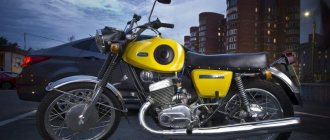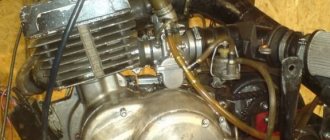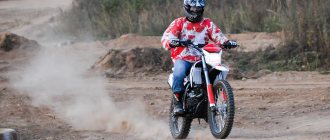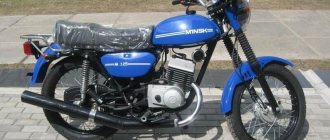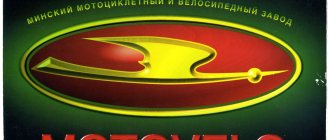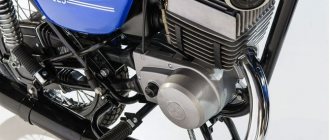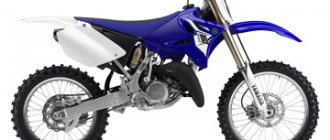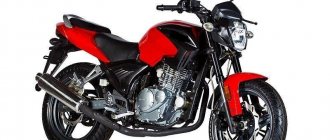Motorcycle Minsk D4 125 characteristics review
Minsk D4 125 produced at the Minsk-Moto plant. The model has a single-cylinder four-stroke carburetor engine with a power of 10.5 liters. strength The gearbox has five gears. The fuel tank has a capacity of 12 liters and is filled with fuel not lower than A-92. The engine starts using an electric starter, but there is also a kickstarter. The seat is covered with a special material protecting the motorcyclist from sliding off the seat. One thing to note about the brakes is that the front brake is hydraulic (disc) and is operated by hand. The rear block type is operated by the foot.
The ground clearance of the motorcycle is 210 mm. The front fork is telescopic. The rear suspension is pendulum with two shock absorbers. The front and rear wheels are the same size 3.00 by 18. The dry weight of the motorcycle is 100 kg. Maximum speed 100 km per hour.
The instrument panel and control switches are visible in the photo. In general, the motorcycle is not bad, cheap, affordable.
Return to contents — ↑
Specifications
Today the Minsk-125 seems like a relic, but in its time it was quite good. First of all, it must be said that its weight was only 120 kg, it provided everything necessary for comfortable movement with a passenger. Even a novice motorcyclist can cope with the control of the bike. The Minsk is easier to control than many other Soviet bikes. It is driven by a 12-horsepower two-stroke air-cooled engine. The transmission contains a four-speed gearbox. Many Soviet motorcyclists were pleased with the strong, steel frame, and the quality was so good that even decades later it was possible to find rust-free motorcycles, provided they were stored in proper conditions.
The motorcycle tank is designed for 11 liters, and the consumption of the Minsk-125 is only 3 liters for every 100 km. Here it is worth taking into account the fact that gasoline is poured into the engine of the 125 Minsk along with oil. The braking system of the motorcycle is represented by drum brakes. The design is extremely old, but just as reliable and durable. The brakes are incredibly grippy, and if you give them the necessary attention, they won't cause any problems. It is necessary to change the pads in a timely manner; the good news is that there will be no problems with their purchase even today. A pair of shock absorbers are installed at the rear of the motorcycle, and a very ordinary telescopic fork is installed at the front. Many were not satisfied with the factory softness of the suspension, so they additionally installed a spacer in the fork and took other tricks. But too soft suspension is a feature of many motorcycles produced in the Union.
Motorcycle Minsk R250
Minsk R250, twin brother of Megelli 250R, the only difference is the brand name on the side. But it is worth noting that Minsk is assembled in Belarus, and its clone in China, although it was designed in Europe.
Minsk is ready for sports driving, and can prove it exactly as much as the pilot demands. And all this thanks to the rigid “birdcage” frame. For drivers taller than average, it will be inconvenient to hide their knees; the side fairings are not designed for tall drivers.
The device is quite decent for clearing traffic jams in the city. But don’t forget about the non-adjustable fork and rigid monoshock, because of which on the roads that are typical for all of us, you can get a good blow to the “butt” or shake your hands.
The 250 has very good brakes, which was a pleasant surprise. But with tires things are much worse. No, you can drive on standard tires, but not more than 60 km/h. The manufacturer, of course, promised to take action. The engine runs smoothly, without failures. I would like some pickups, but alas. 6000-7000 rpm, in this range it produces all its power.
Return to contents — ↑
Motorcycle Minsk 103
The Minsk 103 motorcycle is a further modernization of the M1M motorcycle. It differs from the latter mainly in the design of the chassis.
The installation of a front telescopic fork and a rear suspension with hydraulic shock absorbers (see motorcycles K-125M and K-55) significantly improved the smoothness of the motorcycle. The electrical equipment and ignition system on the M-103 motorcycle are made according to a scheme similar to the M1M motorcycle; the exception is the G 401 generator (instead of G-38 and G-37).
Return to contents — ↑
What was good about Minsk
If we consider the legendary “Minsk-125” further, we can note the following obvious advantages, which often outweighed the disadvantages and pushed motorcyclists to buy a bike:
Light weight . As mentioned above, the bike weighs only 120 kg, which allowed even not very large motorcyclists to move it however and wherever they wanted.
Acceptable dynamics . Today, a maximum speed of 95 km/h will not surprise anyone, but at that time such a performance indicator was considered outstanding. “Minsk” quickly picks up speed and is easy to climb, allowing true motorcycle enthusiasts to enjoy the speed.
Simple design . A motorcycle can be repaired in a garage without any problems; all you need is a set of tools, free time and a desire to repair the equipment.
Inexpensive and accessible spare parts . “Minsk” was distinguished by simple and affordable maintenance; spare parts were not difficult to find and purchase. Even after several decades, the spare parts needed to repair the bike can be found, and for pennies.
Of course, today “Minsk-125” is a bygone era, modern copies produced by the plant no longer have anything in common with the old copies. However, if you walk through the garages of motorcycle enthusiasts today, you will find thousands of Soviet motorcycles, some of them gathering dust, others in use.
The high popularity of the equipment is evidenced by the numbers - deliveries to 45 countries of the world; in total, over 6.5 million copies of the motorcycle were produced. From the first years, “Minsk” began to take part in cross-country and circuit racing. The first cross and enduro M-201M were created in 1956. In the 90s, the motorcycle became a favorite among young motorcyclists. First of all, for ease of control . It is much simpler and easier to operate than the Ural, IZH or Voskhod. Plus, I had to refuel much less often, since fuel consumption per hundred is scanty. There were some shortcomings, for example, not the most reliable engine, but often this factor was not paid attention to.
Minsk M-103.
Minsk M-104.
Minsk M-105.
Minsk-125.
Minsk-125.
Minsk-125.
Minsk M-201M 1956 (the second “M” stands for “multi-day competition” - the predecessor of modern enduro) long-link front fork of the Earles system, rear pendulum suspension and boosted to 6 hp. engine.
edit this post
Motorcycle M1M Minsk - overview of characteristics
The M1M is similar in engine and power transmission design to the M1A and K-125, but differs in the design of the front fork.
The M1M has a front wishbone fork. Pipes 1 of the right and left fork stays are secured in the upper and lower bridges with clamps secured with bolts. A steel box-shaped tip is welded to the lower end of the pen tube. There is a spring 2 in the feather tube. In the walls of the tip on the horizontal splined shaft 6 there is an outer lever 10, in the disk of which the wheel axle is mounted, and an inner lever 5, which rests against the spring through a pusher 4. The friction shock absorber consists of one movable disk 16 mounted on a splined shaft and two fixed steel disks 17, between which friction washers 21 are installed. The disks with washers are compressed by the spring 20 of the shock absorber cover 19. The shocks received by the wheel through the outer lever 10 of the wheel, the splined shaft 6, the inner spring lever 5 and the pusher 4 are perceived by the spring 2 of the blade and partially by the shock absorber. To prevent hard impacts, the feather has lower 7 and upper 22 rubber buffers. The shock absorber is adjusted by tightening the cover 19.
As a rear suspension, the M1M is equipped with a lever spring suspension with a friction shock absorber. The wheel axle is installed in the eye of the swinging rear fork; Between it and the fangs welded to the stationary part of the rear fork, hinged spring suspension elements are installed, covered with telescopic casings with a seal. Parallel to the spring element, the levers of a double-acting friction shock absorber with adjustable resistance are connected to the tusk and to the ball ring on the oscillating fork.
Since October 1954, electrical equipment with a G-37 alternator and an FG-17 headlight has been used in Minsk. Installed instead of a G-35 DC generator and FG-3 headlights. The ignition coil, signal, low and high beam switch, rear light and battery are used from the previous M1A electrical equipment set.
Return to contents — ↑
MY MOTORCYCLE
Minsk, or in common people “Makaka” - probably many began their journey in biker life with this motorcycle.
You could see him everywhere. Economical, simple, not expensive and small, that’s how you can describe it. By the way, my first motorcycle that I learned on was a Makaka. Now her relative is lying in my attic, I can’t find time for her. “Soviet motorcycles produced after 1945 have perfect engines, which can be started easily and quickly,” the instructor quoted memorizedly, without expression. He spoke for a long time. And the engine, overheated by training driving (a dozen cadets from the first group made it hot with inept starts and “crawling” in first gear) finally cooled down. And it started. That's what they wrote about him in one of the motorcycle magazines. Probably, for many, these motorcycles, which in the late forties and early fifties were the main training equipment in DOSARM and then DOSAAF motorcycle circles, are firmly ingrained in their memory. Uncomplicated, obedient, cute cars.
Who knows what their story is? Let's talk about this, but in order. The ancestors of modern Minsk began to be produced simultaneously in 1946 by two enterprises. These are the Moscow Motorcycle Plant (in the pre-war years - bicycle plant) and the Degtyarev Plant (ZID) in Kovrov. The first, let's call it MMZ for brevity, already had some experience in the production of motorcycles. In 1941, in cooperation with EIS (later called ZIL), which made engines, and with the KIM plant (AZLK), which supplied gearboxes, it produced M-72 vehicles. After the end of the war, he was entrusted with the production of the Ml A model, called “Moscow”. Design work on it was headed by S. Semashko. And in Kovrov, where the main products were associated with the name of weapons designer V. A. Degtyarev, in 1946 the production of civilian products began - motorcycles. To develop drawings of the K-125 model of the 125 cm1 class, a special design bureau was created under the leadership of N. Lopukhovsky.
Both in Moscow and in Kovrov they took the German motorcycle DKV-RT125 from 1940 as a basis. It was an advanced design for its time, and also very technologically advanced. Its creators wanted to see it as a Volkswagen motorcycle. The motorcycle was a harmonious combination of such technical solutions as an engine in a block with a gearbox, two-channel loop blowing of the cylinder, constant mesh gears in the gearbox, and gear shifting by pedal.
The DKW plant in Zschopau, located in the Soviet zone of occupation, was subject to dismantling by decision of the Allied authorities as an enterprise that supplied weapons to the Wehrmacht. Equipment, fittings, and technical documentation were taken to Moscow, Izhevsk and Serpukhov as compensation for damage caused by the enemy to the national economy of our country. Based on German drawings and technology, the M1A and K'125 motorcycles were born at MMZ and ZID, and already at the end of 1946, both enterprises launched their serial production. It must be emphasized here that soon after the end of the war, but two years later, our factories mastered production of models that were copies of the DKV-RTI 25, such well-known in the USA (since 1948), BSA in England (since 1948) and Yamaha in Japan (since 1954). The English BSA-D1 was a mirror copy of the German motorcycle: the reverse gear chain was located not on the right, but on the left, the gear shift mechanism moved to the right side, etc. And in the city of Zshopau (then already in the GDR) in the buildings of the former DKV plant The IFA enterprise (since 1956 it was called MC) began to produce IFA-RT125 motorcycles in 1948. And the branch in Ingolstadt (Germany) also resumed production of this model under the original name. Thus, by 1950, eight factories in seven countries were producing the same design. The Soviet counterparts Ml A and K-125 differed in some ways. And not just the emblems on the fuel tank. The differences mainly concerned electrical equipment. On the M1A, the ignition key and warning lamp were located in the headlight, and on the K-125, the reel, relay, ignition switch and other devices were located in one block - a black box under the seat. Otherwise, both cars were identical. The engine and gearbox were located in a common crankcase, which was “halved” like a walnut. The connector of the crankcase halves is vertical, longitudinal. The engine itself, although it had a cast iron cylinder, was quite light - 17.5 kg. This was achieved not only by the compact design, but also by the crankcase and cylinder head cast from aluminum alloy. Hermann Weber, under whose leadership the DKV-RT125 was created, decided to use a cast iron cylinder not only because of the low cost of the material. During casting, cast iron ensured good filling of the mold, and thus it was possible to ensure high accuracy of the configuration of the purge channels. But cast iron parts work well in compression. Therefore, Weber decided not to attach the cylinder to the crankcase with a flange and short studs, but rather the head with independent bolts. He turned to aviation practice: he connected the head and cylinder to the crankcase with long anchor pins, freeing the cast-iron cylinder from massive bosses and flanges. For a mass-produced low-cost model, the optimal solution turned out to be a two-channel loop blowdown according to Schnürle’s patent. With this design, there is no need to install a deflector ridge on the bottom of the piston, i.e., the piston becomes easy to manufacture. Today, for many motorcyclists, such pistons are a completely unfamiliar anachronism, but in the thirties, many two-stroke motorcycle engines still retained deflector scavenging. The air filter is in the spirit of the times: tiny by today's standards and very ineffective. It is not surprising that the piston rings sometimes had to be changed after 4 thousand km. One would not expect anything else from a filter consisting of a set of stamped meshes rolled into a metal body with a diameter of only 70 mm.
The noise level was not measured then, but subjectively the Ml A engine worked quite quietly. Almost everyone admired the graceful shape of the chrome exhaust pipe, bent in a parabolic curve. She dominated the appearance of the car. The M1A and K-125 engines ran on any type of gasoline (even A-661), and their compression ratio was only 6.25. Moreover, the engine characteristics were quite flexible: the engine developed the greatest power at 4800 rpm, and maximum torque occurred at 3400 rpm. In this case, only three gears in the transmission were quite enough. A very compact kickstarter and foot shift mechanism, and a small center-to-center distance (37.5 mm) of the gearbox shafts made it possible to reduce the size of the gearbox to a minimum. Today we are no longer familiar with frames, the parts of which were connected not by welding, but by hard solder. And then soldered frames were common and the welded structure of Ml A was an advanced technological solution. It is important that it was very light - only 5.2 kg. But don’t be fooled by such a small mass. Let us remember that the front fork was of a parallelogram type without shock absorbers, and there was no rear wheel suspension. By the way, when in 1952 ZID modernized the K-125 and equipped its motorcycle with a telescopic front fork with a single-acting hydraulic shock absorber, the dry weight of the machine increased by almost 4 kg.
And when production of the K-55 with a front telescopic fork and spring suspension of the rear wheel began in 1955, the dry weight of the motorcycle rose to 84 kg (and for the Ml A it was only 71). The frame also became heavier. Model Ml A, which received the nickname “macaque” among motorcyclists, was a good machine that was easy to repair and allowed errors and blunders in operation. The motorcycle was a single-seater and was equipped with one set of pegs. The factory only provided a trunk above the rear wheel, but it was sometimes used as an uncomfortable saddle for a passenger. And he could only hug the driver tightly around the waist and, due to the lack of footrests, dangle his legs. Driving the Ml A at night was not pleasant - the car was equipped with a very low-power generator. Judge for yourself: for everything about everything, some 35 W1 What could a “macaque” do? According to the passport, its maximum speed was 70 km/h. But a well-oiled car with an engine that had been run in according to all the rules could please the owner at 75-80 km/h, especially if he was driving crouched down. Fuel consumption was low: at a speed of 50 km/h - only 1.9 l/100 km. True, at 60 km/h it rose to 3.3 l/100 km. The fuel tank held 9 liters of the mixture: it was prepared in a ratio of 1:25 or 1:20. Of course, with a rigidly mounted rear wheel, driving on a dirt road turned out to be quite shaking and uncomfortable. But this shortcoming was somehow compensated for by the springs of the saddle and the driver’s position with his legs bent at the knees. The ground clearance for such a “dragonfly” as the M1A, equal to 142 mm, made it possible to drive on shallow ruts without the risk of losing the muffler or running boards... MMZ produced “macaques” until 1951. Then the plant changed its production profile, and the Ml A car began to be made according to based on his drawings and technology, another enterprise is the Minsk Motorcycle Plant.
Now let’s get acquainted with the modifications of the “macaque” and the further development of its design at these three factories. Moscow Motorcycle Plant .
From the very first months of operation, the plant began creating sports and racing modifications. Already in 1947, he produced the M1E car for circuit racing in small batches. Of course, each athlete refined it, and ultimately, a design was formed based on collective experience.
Then, in 1951-1953, it was allowed to use methanol as fuel, and the national ring championship in those years was played annually in Tallinn. The riders had to cover 202 km. and motorcycles of the 125 cm/cc class (these were overwhelmingly M1E with forced engines) consumed 11-12 liters of methanol per 100 km. The tank is designed for 20 liters. Of course, the engine’s phases were expanded (“windows were sawed off”, the edges of the pistons were trimmed), the head and cylinder mounting studs were strengthened, the compression ratio was increased to 16 units, and two K-30 carburetors were installed on a common pipe. How was this expressed in horsepower? 10 liters. With. at 5400 rpm! And thirty-five years later, on the MMVZ-3.112 motorcycle (I emphasize - on a road motorcycle), the power was 10 hp. With. at 5500 rpm and with a compression ratio of only 9.5 to serial carburetors that have an air filter with a muffler. The MTs-TS125 road motorcycle of 1953, also developed from the DKV-RT125, has similar indications.
The racing M1E was created in those years when motorcycle engine designers knew little about the oscillatory processes of gases in the intake and exhaust systems. Therefore, the car had a short megaphone on the exhaust pipe, which amplified the exhaust sound to an unbearable level, but did not improve cylinder cleaning and increase power. The diameter of the megaphone was 90 - 95 mm, and when driving under their own power outside the race tracks (and then this was in the order of things), athletes inserted the toe of a boot into the bell of the megaphone in order to somehow tame the sound. The super-boosted MlE for the stars on a kilometer run, lightweight to 60 kg, with a 10-horsepower engine and with a recumbent landing of the rider developed a speed of 122-124 km/h. The reliability of such a motor was low, and it was no longer possible to achieve a further increase in power by force. In 1951, under the leadership of designer I. Okunev, a four-stroke overhead valve engine was designed on an M1E crankcase. Its power reached 12-14 hp. s, but with the previous gearbox it was not possible to fully implement it at races. This racing motorcycle was called M1Shch. At the same time, in the same 1951, another racing motorcycle was tested - the M1 K with a two-stroke engine that had water cooling and a supercharger. Its power is 16.5 hp. With. It is curious that in 1949 a variety of M1E was built, but not of the 125 cm3 class, but of the 100 cm3 class. The engine of this motorcycle developed a power of 7.5 liters. s at 5000 rpm. The highest speed is 209 km/h. Another important modification of the Ml A motorcycle appeared in 1951 and was intended for cross-country competitions. This is an Ml B machine with a telescopic front fork, hydraulic shock absorbers and a rear pendulum spring fork. It was equipped with boosted up to 7 liters. With. engine. MMZ planned to equip a serial road model with a “telescope”, as, however, the Kovrov plant did in 1952, but did not have time,
Plant named after Degtyarev.
In 1952, he switched to producing the modernized K-125 model. Until this year, the M1A and K-125 differed only in emblems, colors and electrical equipment. The modernized K-125M vehicle of 1952 received a telescopic front fork with a single-acting hydraulic shock absorber. The base has become 35 mm longer and the dry weight has increased by 3.2 kg. The next step is the K-55 model (1955-1957). It had a pendulum rear wheel suspension, the K-30 carburetor was replaced by the K-55, and engine power increased to 4.75 liters. With. Improvements affected the clutch (the number of discs was increased) and a number of other elements. The introduction of rear suspension and the complication of the frame led to an increase in dry weight to 64 kg.
Then, in 1957, K-58 was born. Essentially, it was a K-55 with an AC electrical system, a more reliable clutch release mechanism, and a larger gas tank (up to 10 liters). Improvements in the engine made it possible to increase power to 5 hp. With. at 5200 rpm and speed - up to 75 km/h. The K-58 motorcycle turned out to be 4 kg lighter than its predecessor. This is precisely the mass that the ZMT-7 battery had, which became unnecessary with alternating current electrical equipment.
And then? Then, in 1958, the plant mastered a new model - K-175 and in 1960 finally parted with the 125 cm class. Of course, Kovrov residents, like Muscovites, created racing and motocross modifications based on the K-125. In 1946, the K-125S, an analogue of the M1 E, appeared; poezhe. in 1949 - K-125S1 with a telescopic front fork (development of the K-125S), and in 1950, a batch of K-125S2 cross-country vehicles with a “telescope” and pendulum suspension of the rear wheel was released.
Minsk Motorcycle and Bicycle Plant.
At first he collected (in 1951, three thousand pieces) M1 A motorcycles, but then completely mastered their production. The telescopic front fork of the MMZ design was introduced back in 1953. In October 1954, the first important innovation of the plant was an electrical equipment system with a G-37 alternating current generator and a new headlight.
Radical changes came at the end of 1956, when the M-1M road motorcycle was released. New in it were: a front pendulum short-lever fork, a pendulum spring suspension of the rear wheel, a reinforced frame, and a guard raised above the wheel. A new muffler and modified valve timing increased power to 5 hp. With. With the new wheel suspension, the wheelbase increased to 1285 mm, and the dry weight increased to 79 kg. And yet, in 1962, the chassis of the Minsk motorcycle underwent another modernization. The plant abandoned the wheel suspension with friction shock absorbers and a short-link pendulum front fork. He made the wheel suspension traditional, similar to the Kovrov K-55 and K-58, which gained a good reputation among motorcyclists.
In addition, this new model (M-103) began to be equipped with a contact-oil air filter instead of a mesh air filter - an important improvement, considering that the machine was intended for a rural consumer. But the motorcycle's power unit remained virtually unchanged. Individual evolutionary improvements affected the periodic increase in power and little by little decreased flexibility of the engine.
Since August 1964, production of the M-104 began, a model with a new muffler, boosted to a power of 5.5 liters. With. engine and a tribute to fashion in the form of a double cushion-type saddle and facing panels near the carburetor and the seat part of the frame. The car gained weight (dry) - 90 kg, and began to reach speeds of up to 75 km/h.
M-105 is a continuation of the ongoing modernization of the design, the foundations of which were laid long ago. MMVZ began making this car in 1966. A lot of work was done to increase the engine power to 7 liters, increase its reliability (bearing of the lower connecting rod head with a separator), introduce rear chain casings, and introduce a new throttle handle. But the main innovation is the four-speed gearbox. It was not born from a good life. The constant increase in engine power narrowed its operating range and three gears became not enough. Evolution continues to this day.
In 1972, the plant began producing the M-106 motorcycle, then from November 1972 - the SZ.111 model, and from June 1980 - the 3.112. And so, when on one of the modifications of this motorcycle, namely on the “3.112.1” car of 1984, a power of 12 hp was achieved. at 6950 rpm, and the highest torque of 1.2 kgf/m occurred at 6800 rpm, we had to hit the rebound. And in 1987, a new variety appeared - “Z.112.11” with ... a derated engine so that this car could be used not only on highways.
The compression ratio on MMVZ-3.11 2.11 is reduced compared to MMVZ-3.112.1 from 9.5-10.5 to 8.5-9.5 units. The speed corresponding to the maximum power (10 hp) decreased to 5500-6300 rpm, and the maximum torque (1.2 kgf s) - to 5250-6000 rpm. It seems that, despite the alterations made from time to time, the designers are now bound by the available equipment and the development of the basic design of the power unit, which is over half a century old, has reached its limit. By the way, the MC plant has already buried its 125 cc model and only Minsk residents are holding high the banner of the ideas originally laid down by Hermann Weber.
During perestroika, in 1995, production of a new model of the Minsk motorcycle began - MMVZ-3113. 1, in which major changes were made to the engine design, due to which better dynamic qualities of the motorcycle were achieved, as well as increased durability of parts and overall operating efficiency, while at the same time reducing the overall noise when driving. The new model began to use a duplex type frame, which made it possible to increase the rigidity of the chassis and the overall stability of the Minsk motorcycle. The smoothness of Minsk's movement has been improved due to the use of a front fork with a sliding tube, as well as gas-filled shock absorbers.
In 2003, production of the MMVZ-3 modification began. 113. 5 under the Leader brand, which has several “cosmetic” changes compared to its predecessors. In the same year, based on the Leader, a model with a four-stroke engine with an electric starter and a 5-speed gearbox began to be produced. The new Minsk motorcycle received the serial number MMVZ-3. 114, and most of it is currently being exported to the CIS countries and neighboring countries. In addition to the MMVZ-3 model. 114, the production program also includes a motorized trolley (cargo motorcycle) under the S-3 brand. 901. In 2008, the Minsk plant was reorganized, in connection with which the Minsk-moto enterprise was created, which entered into agreements for the supply of modern equipment for the production and assembly of motorcycles manufactured based on the capabilities of the plant.
So, a few months later, new motorcycle models were presented, labeled Minsk 125 Sport, Naked and Motard - each of which has its own purpose.
The plant still exists and continues to delight its fans with new products, despite great competition.
Currently the company produces:
- various models of bicycles: mountain, road, city, BMX, road, teenagers, children, tandems;
- motor vehicles: motorcycles, mopeds, scooters, ATVs, electric scooters.
- Skateboards, hockey and figure skates.
- Related products: potato planters, bicycle trailers, exercise bikes, wheelchairs, equipment and spare parts for motorcycles and bicycles.
On this optimistic note I will end the story about the unforgettable Minsk...
